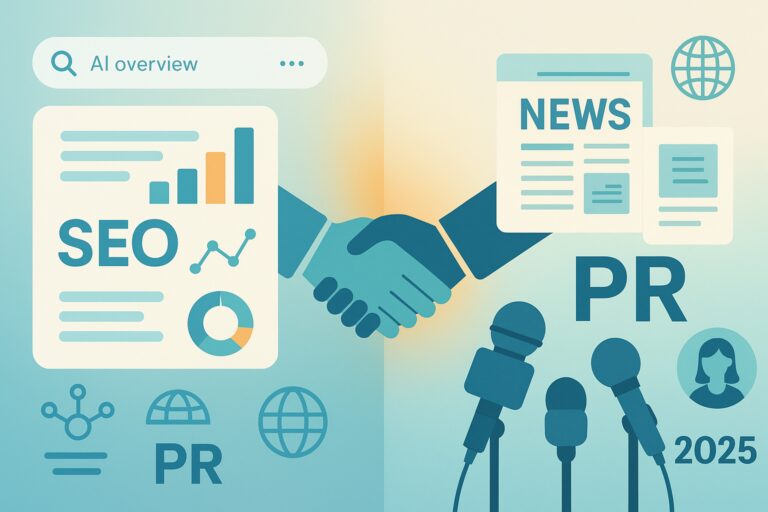SEO and PR in 2025 —Two Sides of the Same Story

Google results today barely resemble the tidy page of ten blue links we knew a decade ago. Now the engine writes its own answer before you can blink, shows only a handful of citations, and checks whether the author has first-hand credibility in the topic. In that reality, the only reliable path to visibility is to fuse the data discipline of SEO with the narrative craft—and relationships—that sit at the heart of public relations.
How Google Changed the Rules
In December 2022 Google renamed its famous E-A-T rubric “E-E-A-T,” adding Experience to expertise, authority and trust. The quality-rater handbook tells reviewers to reward content created by people who have done the thing they’re writing about, not just studied it.
Less than a year later the company unveiled AI Overviews, a generative summary that appears above conventional listings. The feature moved out of Search Labs and into every U.S. result page in May 2024 and is on its way to more than a billion users worldwide.
Google also wove its 2023 Helpful Content system into the core algorithm, explicitly demoting pages written “primarily for search engines rather than people.”
The cumulative effect is clear: thin guest posts, recycled press releases and other spray-and-pray tactics no longer earn the clicks—or the trust—they once did. Credible storytelling, backed by data and genuine expertise, now determines who wins both rankings and reputation.
Digital PR: The Link-Building Tactic Algorithms Can’t Kill
Traditional link schemes have withered under spam penalties, yet backlinks remain a top ranking factor because journalists, analysts and academics still cite the sources they trust. A 2025 BuzzStream study of 150 practitioners found that 95 percent land links by pitching data-led stories and 93 percent do it by providing expert commentary; more than half say they work hand-in-hand with SEO teams. That is exactly the kind of authority signal Google now surfaces inside AI Overviews and other rich results.
What Modern Communicators Actually Do
The job titles on your org chart may still read “SEO strategist” and “PR manager,” but the day-to-day work has blended into a single craft. Winning digital visibility means reading search-intent data with the curiosity of a reporter, then shaping a story editors want to publish and Google wants to cite.
First comes intent intelligence—mining question-based keywords to discover how audiences phrase a problem and what answers already exist. Next, data journalism supplies proof. Original surveys, public-records scrapes or anonymized product analytics provide the first-hand “experience” Google values and the fresh angle a reporter can’t resist.
Because search is now multimodal, teams package multimedia assets—a 30-second vertical video, an audio clip, a chart—along with the article, complete with transcripts, alt text and schema so AI crawlers can understand them.
Finally, communicators still rely on relationship-driven outreach, but success is measured by a hybrid scorecard: rankings, AI Overview citations and referral traffic appear right beside coverage volume and sentiment
One Workflow, Not Two
If PR and SEO share the same raw ingredients—data, subject-matter experts and fresh angles—they should also share the same assembly line. Siloed hand-offs waste time and hide insights that could sharpen a pitch or make a page more crawlable. In a modern “search-plus-story” workflow the steps flow together:
- Discovery pairs a keyword-gap audit with a scan of upcoming editorial themes and social chatter.
- Ideation happens in one room: search specialists share demand data; PR pros shape a hook that satisfies both editors and algorithms.
- Creation is simultaneous—writers draft, SEOs weave in structured data and internal links, designers cut social and video snippets, all before the first pitch goes out.
- Distribution launches on two tracks the same morning: the hero article publishes on the brand site while embargoed pitches hit journalists’ inboxes.
- Amplification repurposes every earned hit into newsletters, LinkedIn carousels, conference decks and thought-leadership posts, reinforcing both link equity and brand authority.
- Measurement rolls into a single dashboard that tracks AI Overview citations, rank movement, referral traffic, media sentiment and pipeline contribution.
Case Snapshot
A mid-market SaaS firm wanted to rank for “supply-chain risk report.” The team surveyed 500 procurement leaders, broke the findings into regional data cuts and published a schema-rich insights hub. Journalists received embargoed access 24 hours in advance. Within three months:
- 22 top-tier outlets—including a national business daily—linked to the study.
- The URL was cited inside Google’s AI Overview for “2025 supply-chain risk trends.”
- Non-brand organic traffic to the report jumped 35 percent and marketing-qualified leads rose 19 percent.
- Every milestone—from keyword selection through reporter follow-up—lived in one shared project plan.
Looking Around the Corner
Alphabet has already begun serving ads inside AI Overviews and says early tests monetize “at approximately the same rate” as traditional search ads. The company recently reported that the new experience reaches 1.5 billion monthly users.
As Gemini 2.0 expands the system’s ability to parse video, code and complex math, brands will need well-tagged multimedia to stay eligible for those coveted citations. Meanwhile, regulators are pressing for clearer disclosure when AI drafts or edits public content—a governance issue PR teams are uniquely positioned to lead.
The Bottom Line

Bill Threlkeld is president of Threlkeld Communications, Inc., a Digital PR, SEO and Content Marketing & Measurement consultancy. Built on three-plus decades experience in Public Relations and Content Marketing. Bill’s unique value is in leveraging PR to create content “clusters” and campaigns integrating a blend of Public Relations, SEO, social media, and content that can be tracked and measured for optimized performance. Bill’s experience includes: tech, musical instrument, pro audio, legal, entertainment, apps, software, cloud services, travel, telecom, and consumer packaged goods.
